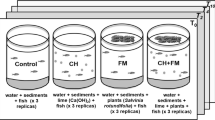Abstract
Results from experiments show that instant dissolution efficiency of calcite powder increases with finer particles, and that initial dissolution efficiency decreases with and increased dose. The Sverdrup model predicts and the results show that the dissolution efficiency is dependent on pH, dose, depth and grinding. Dry application can reduce the dissolution efficiency by 40% in relation to a well slurried application. Experiments in two lakes indicate that residual calcite on the lake bottom cannot accomplish bulk neutralization of the lake even if substantial effects on the microenvironment around the calcite and the reacidification time can be seen. Bioassays with Atlantic salmon indicate that fish mortality due to Al toxicity is greatly reduced when the Ca concentration exceeds 3.5 mg L−1. The results show that the pH and alkalinity in almost any acidified lake can be established and maintained by liming at levels where fish populations can be sustained by natural reproduction.
Similar content being viewed by others
Rights and permissions
About this article
Cite this article
Sverdrup, H., Warfvinge, P. Lake liming in different types of acid lakes using various types of calcite powders and methods. Water Air Soil Pollut 41, 189–222 (1988). https://doi.org/10.1007/BF00160351
Issue Date:
DOI: https://doi.org/10.1007/BF00160351




